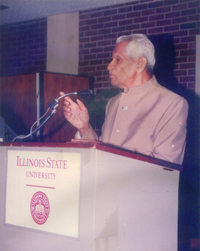Vaidik Heritage/ Tradition

The whole world was following Vaidik philosophy in good olden days, they led a Vaidik life. Vaidik means enlightening. Today, all wise men are attracted by this Vaidik life. Physical science may confer prosperous life, but the whole world has to agree that it would not bring in mental satisfaction and peace. At the core of this Vaidik life is Yoga, of course, spiritual science. Physical and scientific luxury fails to give mental satisfaction and peace, so young people in and out of India are attracted towards India to study ancient Vaidik life. This is a good omen to lead scientific life.
Vaidik Globe (The world is Vaidik)
In olden days the whole world was following the Vaidik tradition. It is very informative and interesting to assess names of various nations, their history and their customs and traditions. Russian linguist Mr. Leb Silenko visited India. Synopsis of his study of linguistics, history, customs and traditions is – in Russia and Europe Vaidik traditions were prevalent. Today also almost 50% words have their etymological roots in Sanskrit. Some words have varied versions of main Sanskrit word. Mr. Lev Silenko has established some branches to study and promote Vaidik life style all over the world.
Scholars from Afghanistan state that Ramayana has taken place in their country because Ayodhya, Sharayu and many countries mentioned in Ramayan are in their country too. Indonesia, (Hindonesia) though it is a Muslim country, takes pride in calling their country, ‘Ramayan County’. Ceylon, Malaya, Singapore, Burma almost all oriental countries believe likewise. In the excavations in Iraq, though it is a Muslim country, a stone having emblem of Swastika and an Iraqi Lady wearing Hindu style sari, are found. These must be 3000 B.C. The symbol of Swastik, and Hindu style sari prove that Vaidik tradition was prevalent in Iraq 5000 years ago.
Russia is really ‘Rishya’, derived from ‘Risheya’. Today also Russian people add ‘Ov’ ( a Sanskrit vocative adjective) to their names. Eg. Chov, Molotov, Garbachov etc. In Mongolia, that lies to the south of Russia, many Sanskrit books are found. To the east are Japan and Korea that follow Buddhist alias vedic traditions. The word Korea has its roots in the Sanskrit word, ‘Kuryat’. Mongolia is derived from ‘Mangalmay’. Nippan is the original word from which Japan is derived. China or Cheen is derivative of the Sanskrit word Pracheen. This again confirms that in China too Vedic tradition was set. To the far south, in Australia –the name of which is derived from ‘ Asuralaya’- still barbarian Maori people inhabit. In spring, sign of Swastika depicts traces of Vedic tradition.
Africa continent was considered to be barbaric and backward, but many countries in North Africa are derived from Sanskrit. Eg. Egypt- Agupta, Sahara – Ashray, Nubba – Nav. 2500 years before Sahara was a thick forest sheltering thousands of species and men. Unfortunately, today Sahara is a desert. Vaidik tradition doesn’t believe in idol-worship but believes in god without any form.
Thus, the whole world has been Arya, Dravid and Vaidik and people have forgotten this. Every human being irrespective of his religion, sect or cult is Vaidik first.